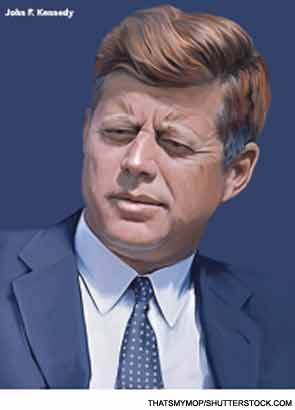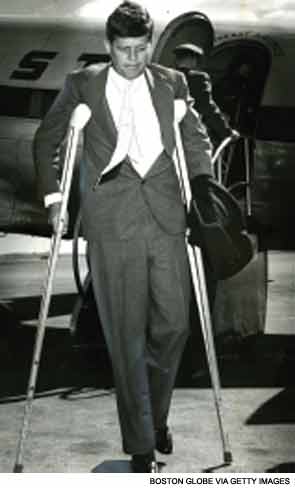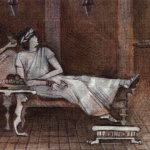

Your next patient, Jack, is a real charmer. A bit gaunt with a mop of unruly hair, his cheerful demeanor belies his extensive medical history. As you skim through the first stack of his lengthy medical file, you are taken aback by the gravity of his condition. Ten years earlier, at the age of 17, he was hospitalized at Yale–New Haven Hospital, Conn., and subsequently at the Mayo Clinic in Rochester, Minn., for an ill-defined syndrome characterized by fever, jaundice, an urticarial rash, and leukopenia. Despite the lengthy admissions, the cause of his illness was not discovered. His fever eventually resolved, but the leukopenia persisted. One eminent hematologist speculated that Jack was suffering from some form of preleukemic syndrome.
A few years later, a new problem arises: cramping abdominal pain coupled with alternating bouts of occasionally bloody diarrhea and constipation. There was some loss of appetite and weight loss. Could his symptoms be due to colitis? Imaging studies of the bowel were inconclusive. Jack’s East Coast doctors speculated that he suffered from irritable bowel syndrome. You flip through some papers and find a summary note from the gastroenterologist at the Mayo Clinic who concluded that the symptoms were caused by a “diffuse duodenitis.”
Over the course of the next decade, Jack’s medical condition continued to baffle his many physicians. Aside from the gastrointestinal complaints, he noted frequent hives and described one episode of facial swelling that lasted for a couple of days. In the notes, there are now descriptions of recurrent episodes of “nonspecific urethritis.” Now this is getting interesting. Your rheumatologist’s instincts are starting to lead you in the direction of some form of a reactive process. Yet, you haven’t read about any joint or back pain. Wait a second. Here it is. Back pain. This is the symptom that brought Jack to your office.
He began to notice low back pain about ten years ago. While traveling with some friends through Europe, their car got stuck on a beach in Italy. Jack and two of his buddies had to push the car for nearly two hours before they could extricate the wheels from the sand. Since then, he has complained of back stiffness and began wearing a back brace.
Of course, you are not the first physician to evaluate this problem. This should come as no surprise when you learn that his father, a former United States Ambassador, has all the right medical connections. One noted orthopedic surgeon who examined Jack did not identify any surgical issues. He recommended a conservative approach, focusing on physical therapy and the use of a back support. A second back specialist speculated that the pain was caused by a chronic sacroiliac joint strain, aggravated by very tight hamstring muscles. Yet a third surgeon dissented and pushed for aggressive management of Jack’s debilitating back pain. He recommended a lumbar discectomy.
What was going on? As a rheumatologist, you are considered among the foremost of medical sleuths. Is there any other specialty as renowned for solving medical mysteries? You probe further. Jack recalls a brief episode of blurred vision that required him to wear glasses for a period of time during his years at boarding school. You also note that, despite the frequently administered courses of antibiotics, Jack suffers from recurrent bouts of urethritis. He is extremely eager and anxious to hear your advice. After all, he has a date with destiny. In about fifteen years, by his 43rd birthday, Jack Kennedy will be elected the President of the United States.
A Time To Remember
This month marks the fiftieth year since that fateful day in Dallas when John Fitzgerald Kennedy was assassinated. Those of us who are old enough to remember the Beatles’ invasion of America can probably recall with frightening detail what they were doing when they heard the news of the president’s death. Seeing old film footage of the venerable newscaster Walter Cronkite shedding a tear as he confirmed JFK’s death to a stunned world still sends shivers down my spine.
To commemorate the president’s passing, I decided to spend some time in the magnificent JFK Presidential Library, which sits proudly atop Columbia Point on the shores of the Massachusetts Bay in the Dorchester section of Boston. There are some marvelous permanent displays highlighting Kennedy’s days as president. Small crowds gather to watch the numerous video clips of the photogenic Kennedy, his elegant wife, Jacqueline, and their two young children, Caroline and John Jr. We can gaze at photos taken on the presidential campaign trail more than 50 years ago. There are thoughtful interactive presentations that allow visitors to probe into the major political matters of that era, including the civil rights movement and the Cuban missile crisis.
The library also holds more than 400 collections of personal papers and institutional records ranging from the White House files of JFK’s closest advisors to the largest collection of papers left by the estate of Ernest Hemingway. Until recently though, the president’s personal medical records were off limits to researchers. In 1983, the Kennedy biographer Herbert Parmet observed that “dealing with the Kennedy medical history is in some ways like trying to uncover aspects of vital national-security operations.”1 Another noted Kennedy biographer, Robert Dallek, unearthed a fascinating historical nugget. Richard Nixon may have tried to gain access to Kennedy’s medical history. In the fall of 1960, as he and JFK battled in what turned out to be one of the closest presidential elections ever, thieves ransacked the office of Dr. Eugene J. Cohen, a New York endocrinologist who had been treating Kennedy for Addison’s disease. When they failed to find Kennedy’s records, which were filed under a code name, they tried unsuccessfully to break into the office of Dr. Janet Travell, an internist who had been relieving Kennedy’s back pain with injections of procaine. Although the thieves remain unidentified, Dallek speculates that they were Nixon operatives.1 Was this a prelude to the Watergate break-ins? Had the burglars succeeded, they would have found a lengthy daily medication list including: hydrocortisone, 10 mg; prednisone, 5 mg; methyltestosterone, 10 mg; liothyronine sodium, 50 micrograms; fludrocortisone, 0.1 mg; ascorbic acid 1000 mg; and sulfa antibiotics, diphenoxylate hydrochloride, and atropine sulfate as needed. There was also the intermittent use of methylphenidate and meprobamate, and intramuscular injections of gamma globulin.

A Search for a Unifying Diagnosis
I was intrigued by previous reports about Kennedy’s medical history and the focus on his Addison’s disease, which was presumably due to an autoimmune pathogenesis. There may have been a genetic component as well, since his sister Eunice suffered from the same disorder. In addition, it has been suggested that Kennedy suffered from autoimmune polyendocrine syndrome type 2, defined by the coexistence of autoimmune adrenocortical insufficiency and evidence of adrenalitis, along with autoimmune thyroid disease.2 Yet, this endocrine diagnosis could not explain most of his medical issues. Thinking as a rheumatologist, it is hard to ignore some of the other aspects of the president’s story that lead one to consider the diagnosis of a spondylarthropathy.
The archives room at the JFK Library is a nondescript subterranean space littered with old photos and various props that are no longer displayed in the library exhibits. At one end of the room, technicians edit old television clips of JFK that will be shown at an upcoming panel discussion. The head archivist granted me full access to the president’s voluminous medical file. However, there were a few rules that I needed to follow: photographing or copying the file was prohibited, though I was allowed to take notes. Over the course of several visits, I had the opportunity to review the president’s medical and X-ray files. I learned some interesting aspects of his history that have not been well publicized.
Kennedy’s gastrointestinal illness began at age 13, when he developed abdominal pain, weight loss, and fatigue. When the pain intensified, his doctors decided to proceed with an appendectomy. This did not relieve his symptoms, which now included diffuse joint achiness and intense knee pains. There were more hospitalizations, including admissions to the Mayo Clinic and the Peter Bent Brigham Hospital in Boston. Abdominal pain remained a constant theme throughout his life and, despite the repeated barium enema studies and the recurring rectal probing via the rigid sigmoidoscope, no clear-cut diagnosis was ever established. Given the history of hematochezia and weight loss, the recurrent episodes of fever, weight loss, and anemia, the diagnosis of inflammatory bowel disease (IBD) needs to be seriously considered. Years later, it appears that one of the indications for treating Kennedy with corticosteroids, aside from his Addison’s disease, was his gastrointestinal illness. Thus, if one assumes that the diagnosis of IBD is correct, this raises the possibility that he also suffered from a spondylarthropathy. Let’s review the evidence. There is the remote history of transient monocular visual impairment as a child (uveitis?) and a history of recurrent episodes of urethritis. At first, his doctors concluded that these were likely sexually acquired, though over time, the diagnosis was subtly changed to “nonspecific” urethritis. I assume that his lack of a robust response to antibiotic therapy may have prompted this diagnostic reconsideration. There are several descriptions of intense knee pain, and I found a few knee X-rays taken during Kennedy’s adult years. They were fairly unremarkable in appearance. Specifically, I did not see any erosions or significant joint space narrowing, though none were taken in a weight-bearing stance.
The Back Pain Conundrum
What about Kennedy’s infamous back pain? Could this be the missing link needed to establish the diagnosis of a spondylarthropathy? His back pain began at an early age. Though some historians date its onset to the episode on the beach in Italy, he may have already experienced discomfort years earlier. According to a Navy medical history recorded in December 1944, “an occasional pain in his right sacroiliac joint” began to be noticed during his adolescence. The pain persisted and worsened over time. He started wearing a back support and underwent spinal manipulation therapy, all with transient pain relief.
During World War II, despite his litany of medical problems, Kennedy enlisted in the U.S. Navy and was assigned to PT-boat duty in the Solomon Islands in the South Pacific. The infamous ramming of the PT-109 boat by a Japanese destroyer in 1943 has been well characterized. All accounts agree that Kennedy played a pivotal role in bringing eleven survivors of the attack from the sea to a remote island. He spent more than ten hours in the water during the ordeal. Almost overnight, Kennedy, who would later downplay his efforts, became a national hero—thanks largely to his father, who ensured that John Hersey’s essay in The New Yorker magazine had mass distribution in a Reader’s Digest reprint. Perhaps the most important lesson for Kennedy was that his inner strength could surmount whatever physical disabilities afflicted him.3
Kennedy’s back pain became his major medical issue, and his father sought many different opinions about how to manage it. He may have had his motives. It seems probable that Joseph Kennedy was doctor shopping for his son. Perhaps he was angling to keep John from returning to battle. In a note to Dr. Paul O’Leary of the Mayo Clinic, he explains:
“The boy is in bad shape, but is talking about trying to get over it for the invasion. They are sending some boats over there but in his condition I can’t see it at all. I am inclined to think that he ought to have some kind of operation on his back if there is any sense to it and then get a long leave of absence … to see if he couldn’t restore his health.”
A few months later, Kennedy underwent a lumbar discectomy at the New England Baptist Hospital in Boston. Much to the chagrin of the surgeon, there was “very little protrusion of ruptured cartilage.”3 In simple English, there was no structural spine disease that required surgery.
I have gazed at Kennedy’s multiple spine films taken before and after his first back surgery. There was no straightening of his spine, squaring of his vertebrae, or shiny vertebral corners that heralded syndesmophyte formation. However, his left sacroiliac joint appeared narrowed in the X-rays taken following his back operation. The surgery failed to improve his pain, and Kennedy resorted to using crutches to get around.
Ten years later, because of his considerable pain and difficulty walking, Kennedy decided to listen to the advice of his surgeon at the Hospital for Special Surgery in New York City, and proceed with a spinal fusion. This was an extremely risky procedure at the time, given Kennedy’s history of Addison’s disease, a diagnosis that was made seven years earlier. His surgical team described their procedure and the perioperative course in a case report published in 1955. They claimed that the “patient had a smooth postoperative course” marked by only “minor complications.”4 In fact, John Kennedy nearly died; three days after surgery, he suffered both a urinary tract infection and a “mild wound infection,” which turned out to be a serious staphylococcal infection. He slipped into a coma and was given the last rites of the church. Miraculously, he recovered and four months later was well enough to undergo a third back surgery, this time to remove the infected hardware from his back.
Till the end of his days, Kennedy suffered from severe back pain. He relied on crutches, painkillers, and trigger-point injections to get him through each day. And there was one other device that he depended on—his back brace. According to Dallek, “On November 22, 1963, Kennedy was, as always, wearing a corset-like back brace as he rode through Dallas. Oswald’s first bullet struck him in the back of the neck. Were it not for the back brace, which held him erect, the second, fatal shot to the head might not have found its mark.”5
Dr. Helfgott is physician editor of The Rheumatologist and associate professor of medicine in the division of rheumatology, immunology, and allergy at Harvard Medical School in Boston.
References
- Dallek R. The medical ordeals of JFK. The Atlantic Magazine. December 2002. Available at http://www.theatlantic.com/magazine/archive/2002/12/the-medical-ordeals-of-jfk/305572/?single_page=true. Accessed October 15, 2013.
- Mandel LR. Endocrine and autoimmune aspects of the health history of John F. Kennedy. Ann Intern Med. 2009;151:350-354.
- Giglio JN. Growing up Kennedy: The role of medical ailments in the life of JFK, 1920-1957. J Fam Hist. 2006;31:358-385.
- Nicholas JA, Burstein CL, Umberger C, Wilson PD. Management of adrenocortical insufficiency during surgery. Arch Surg. 1955;71:739.
- Dallek R. An unfinished life: John F. Kennedy 1917-1963. New York: Little Brown & Company; 2001.


